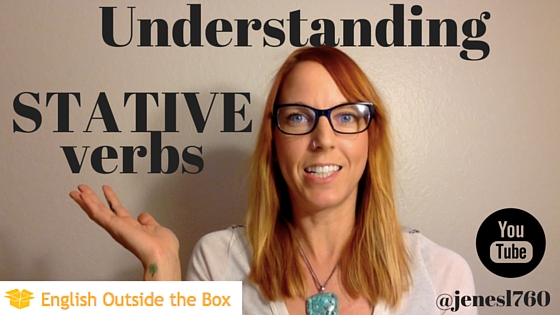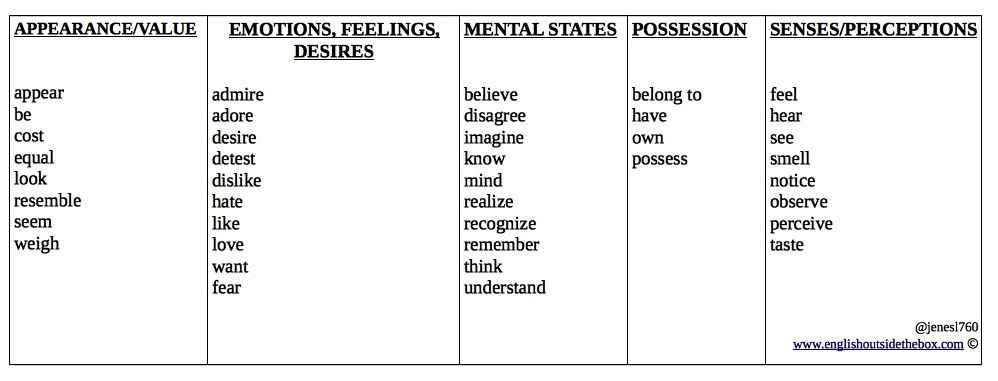
What is a Stative Verb in English?
Today we’re going to talk about 2 kinds of verbs
Action verbs are easy, they’re the majority of the words you use daily when you communicate what you are doing. For example, right you are reading this post and I was writing it earlier. In a minute, you’ll be listening to the YouTube video, and I’ll be talking. While you’re watching the video, you’re probably sitting at your desk. How did you find me and this post? Maybe you were checking out my blog, looking for updates, or perhaps you were surfing the Internet.
There are so many action verbs and these verbs, as you see, can be used in the -ing form (also known as the present participle). These verbs aren’t the main focus of this video though, as I want to give you more information on the stative verbs, because these are the verbs that are a bit more confusing and have more rules and restrictions.
So, what is a stative verb?
…and I found that my desire to make a pretty image actually confused people.
This is why I don’t care to share inforgraphics and images on Instagram, I’d rather give you REAL English in context. However, let me try and make sense of it now.
As we can see, a stative verb describes states of being and these states are often unchanging because they represent situations that last some time. Action verbs, on the other hand, can change quickly. I could be talking one minute, then listening another, then not doing either of the two. This is a very simplistic way to explain this, but I hope that helps you understand this idea of “unchanging”
One of the most important rules of the stative verb is that these verbs are not used in the -ing form, and the easiest way to learn or practice is by separating some of these verbs in categories. We’ll begin with these here…

While you are looking at this list, you may see a verb (LOVE) that surprises you.  Maybe because you are thinking of a certain fast food company that uses this verb in the -ing form.
Maybe because you are thinking of a certain fast food company that uses this verb in the -ing form.
Just know that grammar isn’t always used correctly when it comes to entertainment and advertising. Love shouldn’t have the -ing ending.
Can a verb be an action and stative verb?
Some of these verbs have more than one meaning. If the verb has more than one meaning, then yes, it’s very possible for the verb to be both a stative verb and an action verb. Remember the infographic earlier? I gave an example with think as both a stative and an action verb. When we use it with the meaning to “believe”, then this verb should not be in the -ing form. Our beliefs are things that don’t change too quickly, so these beliefs represent the stative verb (notice it in the “mental states” category on our list). On the contrary, we have the action verb to think, like ”
Hmmmmmmmm I wonder what you are thinking right now? I know that I am thinking about dinner, what should I make? Should I cook enough for leftovers?”
These thoughts are going through my brain, and as quick as I think of 1 thing, I am quickly moving to another topic. These quick moving (or changing) actions are the reason why this meaning of think is an action verb.
Another common example is the verb have. When we use it as ownership or possession, it’s stative. And you know what that means, it’s never in the -ing form. Some examples of the stative verb: I have a car. I have 2 cats. I have glasses. I have red hair. You get the idea? There’s a good chance, though, that you may have heard someone saying, “I am having so much fun!!!” or “I’ll call you later, I am having dinner.” In the first example, “I am having so much fun”, I am describing what I am experiencing, and this experience can change just as quickly as it started. I don’t own or possess this “fun” that I am having, so I hope you can see the difference. In the other example, “I am having dinner” I am using “having” the same way I use eating…
Below, you’ll see the related YouTube video. Make sure you pop over to the channel to watch even more videos! Keep scrolling down on this post, because at the end you can complete the exercises to practice what you’ve learned today.
Exercises to Practice
The following verbs can be STATIVE or ACTIVE. From context, fill in the blank with the correct answer. You will need to use the correct form of the BE verb if the verb needs to be in the progressive form
EX: I _________ dinner right now, it tastes delicious! (HAVE)
answer: I am having dinner right now, it taste delicious!
1. I _______ Dylan now, we’ve been together for 2 months. (SEE)
2. I ______ Dylan now, he’s coming this way. (SEE)
3. Lucy _______ tired, she must have had a long night. (LOOK)
4. Lucy _______ for her keys but can’t find them anywhere (LOOK)
5. Paulo thinks this dish _______ too spicy. (TASTE)
6. Paulo _______ this dish to see if it’s too spicy. (TASTE)
Complete the sentence with the correct form of the verb from each of the categories listed below, you’ll need to identify the verb and its form
1. appearance/value
I _______ my mother a lot, many people say we are alike.
2. emotions/feelings/desires
I _______ the TV show Nashville so much right now, it’s so entertaining.
3. mental states
I don’t _________ doing the dishes tonight. You cooked, so I would love to help you.
4. possession
This phone __________ Emma, I __________(not) an Android
5. senses/perceptions
I ________ something burning right now, is the oven on?
SEE ANSWERS HERE:
Happy Studying! ♥
Did you like this post? Please share it with someone you know learning English. Thank you!
The Conversation Club will provide you with 6 group conversation calls to practice with a real teacher and a group message community to connect with other members.
You will also get weekly English lessons to help your vocabulary, listening, reading, pronunciation, and more!
Try the Club for 1 week, free! Join the 1-week free trial here.

Thanks for Sharing this info with us.Really informative keep on updating.
Spoken English Classes in Navalur | Spoken English Classes in Sholinganallur | Spoken English Classes in Perungudi
So informative! Thanks for this post. I’ve been speaking English all my life and didn’t know the difference between these two verbs.